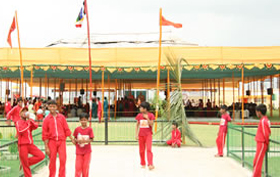
Between the 8th and 12th of September 2011, the first yajna of Sannyasa Peeth took place in Munger. In the presence of Swami Niranjan and Swami Satyasangananda, the Lakshmi Narayan Mahayajna was held on the banks of the river Ganga at Paduka Darshan, performed by pandits from Tryamabakeshwar and conducted by the children of Bal Yoga Mitra Mandal.
The beginning of any spiritual event is very significant. Before anything starts, there is only potential. When that potential is initially activated, harnessed and directed into manifestation, indications are given of possible future development and capacity. If in the beginning an event is accompanied by positive signs, this indicates that the future will be auspicious, creative, benevolent, and beneficial. These indications also show the governing forces guiding and directing the event, in much the same way that an astrological birth chart shows the different planetary influences on an individual.
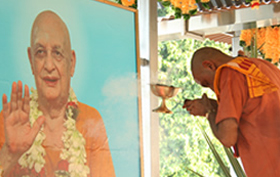
The guiding force of the Lakshmi Narayana Mahayajna is Sri Swamiji. If the yajna was a building, Sri Swamiji would be the architect who drew the blueprint, for it was he who envisioned, planned and gave the instructions that would bring the yajna into existence. In 2009 Sri Swamiji outlined his third vision and mission to Swami Niranjan. That vision was of sannyasa as a lifestyle whereby the expression of the positive and creative qualities could flourish for the betterment of humanity.
Following the instructions and mandate given to him, on 6th December 2010, the punya tithi of his Guru’s Mahasamadhi, Swami Niranjan established the new institution Sannyasa Peeth at Paduka Darshan, Munger. The Lakshmi Narayan Mahayajna was chosen by Sri Swamiji to be the signature program of Sannyasa Peeth and the medium by which his blessings and grace could be received for the peace, plenty and prosperity of all.
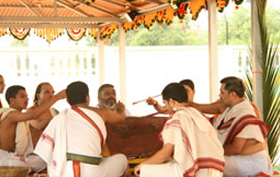
The pandits who would conduct the yajna are from Tryambakeshwara, the temple of the jyotirlingam famed for manifesting the three faces of Brahma, Vishnu and Mahesh. This is the place of Lord Mrityunjaya, the ishta devata of Sri Swamiji. Tryambakeshwar was the place where Sri Swamiji made his sankalpa to dedicate himself to the mission of his Guru for twenty years. Bihar School of Yoga at Ganga Darshan in Munger and the global yoga renaissance is the result of Sri Swamiji’s surrender and the grace of Lord Siva. Again when Sri Swamiji renounced Munger, he returned to Tryambakeshwar where he received the instruction, “Go to my Chitabhoomi” and the vision of his second mission, Rikhiapeeth, was revealed to him. It is only fitting then, that on the dawning of Sri Swamiji’s third vision, the pandits chosen to conduct the first yajna of Sannyasa Peeth would bring with them the benevolent grace of his ishta devata Lord Mrityunjaya.
In the Puranas it is said that in the spheres above this world is the celestial path of Narayana. Above the sphere of the sapta rishis, (ursa major) is Dhruva, the pole star, the pivot or axis of the whole planetary circle. The space between the sapta rishis and Dhruva is known as Vishnupada, the splendid celestial path and abode of Narayana. This place is home to all enlightened beings, saints, siddhas and sages who are purified, radiant with the tejas of illumination and whose consciousness is interwoven with all that is, has been and shall ever be. From the abode of Narayana, they radiate their blessings and compassion for all beings. That Sri Swamiji chose Lakshmi Narayana as the yajna to be conducted at Sannyasa Peeth after his Mahasamadhi is a beautiful reminder that he is eternally present and bestowing blessings upon us all.
Initially the yajna was planned to commence in 2012, but there were very special astrological events which indicated that the yajna should begin in 2011. The 8th of September, which is Sri Swami Sivananda’s birthday and chosen by Swamiji to be the first day of the yajna, was also Thursday or Guruvar, the day dedicated to Guru. According to the lunar calendar the 8th of September was also Ekadasi.
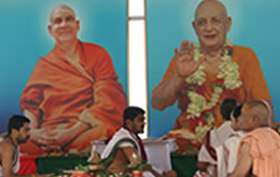
Ekadasi itself is an auspicious day for the worship of Lord Narayana. According to the Padma Purana, in ancient times the devas were being terrorised by a demon named Muran. To end this tyranny, Lord Vishnu entered into battle with the demon for hundreds of years, but was not able to defeat him. Exhausted and needing to devise a weapon to slay the demon, the Lord retired to a cave in Badrikashrama. When Muran attacked the sleeping Narayana, a shakti emerged from the body of the Lord and burnt the demon to ashes with a glance. In gratitude Narayana named the shakti ‘Ekadasi’ and told her to claim any boon. Ekadasi instead beseeched the Lord that all those who observed a fast on that day should be redeemed and in reply Narayana promised that those who fast and worship Ekadasi will attain Vaikuntha.
Ekadasi is the eleventh lunar day of the shukla (bright) or krishna (dark) paksha (fortnight) of every lunar month. During Ekadashi in the Krishna paksha, the moon is at its closest to the Earth and at it’s farthest from the Earth during the Shukla paksha. The moon rules the water element, and the ocean responds to this gravitational pull with higher tides during the time of Krishna paksha and lower tides during the Shukla paksha. Narayana is also associated with the ocean. He is so called because he rests in the waters, nara meaning water and ayana meaning place of abiding. According to the ancient texts, in the beginning of each universe there is only a golden egg or womb known as hiranyagarhba, into which all creative power and potential has been withdrawn. From this golden egg resting on infinite waters, emerges Narayana who lies sleeping in his watery abode for a thousand years. The movement of the oceans surrounding the earth at the time of Ekadasi indicates the proximity of the Lord and therefore it is said that on Ekadasi the doors of Sri Vaikunta remain open for all to receive darshan of the Lord.
The 12th of September, being the sannyasa divas of Sri Swamiji, was chosen to be the final day of the yajna. In 2011, the 12th of September was also Monday, the day dedicated to Lord Siva, the ishta devata of Sri Swamiji. According to the lunar calendar, the 12th was poornima, the full moon, which is not only a very auspicious time for sadhana and spiritual events, but is also associated with Sri Swamiji as he was born on the Margshish Poornima in December.
The circular symmetry of these events is unmistakable. Beside the banks of the river Ganga in 1943 Sri Swamiji surrendered his life at the feet of his Guru. Over fifty years later, beside the sacred Ganga, the ‘samarpan muhurta’, the great moment of dedication which Sri Swamiji experienced, would be honoured by his manas putra Swami Niranjan, with the poornahuti of the Lakshmi Narayan Mahayajna. The final worship of the yajna would be offered at the feet of Sri Swamiji, seeking his blessings for the third vision he had foreseen and the mission he had entrusted.
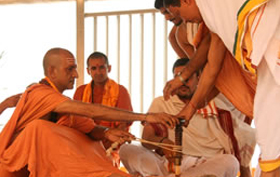
During the yajna a special puja was also conducted by pandits from Varanasi in the Akhara at Ganga Darshan. On the first day, the puja began with the worship of Guru in Guru Peeth, the shrine created after the Mahasamadhi of Sri Swamiji. The pandits continued throughout the day with invocations, offerings and havan for all the presiding deities of the Akhara. Although both the yajna preparations and the Akhara puja were totally independent rituals, conducted by separate pandits, at the exact time when the fire of the yajna had been kindled and the devata agni manifested in flame at Paduka Darshan, the worship of Guru was concluding in Akhara with the flames of the aarati being waved in front of the altar in Guru Peeth. The timing was exact and clearly a sign of Sri Swamiji’s blessings for the success of the yajna.
At the commencement of any yajna a sankalpa is made, to guide and shape the forces which will be awakened and generated by the mantras and offerings made to the sacred fire. The expression of the motivation and vision behind the yajna, the sankalpa is sacred, imbued with the spiritual power and effulgence of the person who has undertaken it. The sankalpa made by a sannyasin who has dedicated themself to the service of others becomes a force of crystallised energy and such a sankalpa has the power to change the vision of the world. The sankalpa for peace, plenty and prosperity as undertaken by Sri Swamiji was also given as the sankalpa and guiding light of the Lakshmi Narayan Mahayajna.
Narayana is the support of the world and the sustainer of the entire evolutionary process from the unmanifest to the manifest. In his embodied form the whole world is interwoven and symbolised. Around his neck Narayana wears the kaustubha jewel, which is immaculate, untainted and pure. Void of all qualities, the kaustubha jewel represents the paramatma, or universal spirit. The first cause and underlying principle of all things, pradhana, is seated on the body of Lord Narayana as the srivatsa mark. The mace he carries represents buddhi, or intellect, and the conch he holds symbolises the panchabhutas or the five elements of earth, water, fire, air, ether. His bow reflects the five sense organs and the arrows the faculties of action and perception.
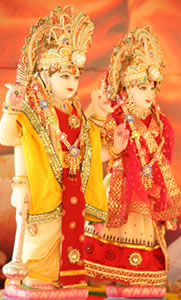
The discuss or chakra in his hand represents the controlled mind, whose thoughts, like the weapon fly like the wind and can be used to protect the positive and destroy the negative conditions of experience. The sword of Narayana represents gyana and vidya, wisdom and knowledge, the weapon that can cut through the bondage and ignorance of worldly existence in an instant, but like the sword can often remain sheathed in the scabbard and not applied in life.
All that is, manifest and unmanifest is pervaded by Narayana and cause and effect are from none other than him. All the five elements, earth, water, fire, air and ether are in him and he is in them. He is all pervading, hence he is called Vishnu. He is the master of past, present and future, the essence of all beings. All things dwell in him, and he is present in all things. He is the performer of yajna, the offering of yajna and the ceremony of yajna itself, the sustainer and support of all.
It is Narayana who bodes himself forth into the world, in different forms from age to age to protect and preserve all that is righteous, true and good. As a gardener has to nourish and sustain the seeds he has sown, so the grace of the Lord protects and nurtures his devotees. When the time comes to uproot the weeds so the plants may flower, the grace of Narayana comes to remove the negative and unhelpful elements and situations in life, so that the positive and uplifting qualities can flourish. Without Narayana there would be no security, protection or peace, and plenty and prosperity could not flower in life.
It is to Narayana that the devas flee for help, when Indra, their king is cursed. Durvasa the rishi bestowed upon Indra a beautiful flower garland, which had been given to him by the Devi Sri herself. In his arrogance, Indra did not recognise the power and importance of the gift and hung the mala upon Airavata, his elephant steed. When Airavata threw off the garland, Durvasa became incensed. Furiously he told him, “Idiot, intoxicated with power, you did not respect the garland I presented, which was the dwelling of prosperity herself. For this arrogance and disrespect your dominion over the three worlds shall be ruined and all prosperity shall leave.”
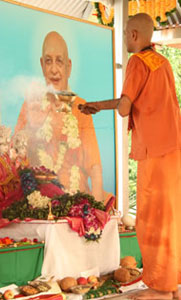
Deprived of the shakti of Sri, the three worlds began to decline. All vegetation withered and died, devout practices and observances were ignored, there was no charity or kindness and moral or social obligations went unfulfilled. Wisdom, clarity and contentment vanished, and in their place desire and ignorance held sway. Those with minds already agitated by desire and ambition became stronger, and put forth their strength against the gods. When the power of the asuras became unstoppable, the tormented Devas and Indra ran to Lord Narayana for refuge.
After hearing their troubles, Narayana instructed the devas to churn the ocean, to produce the ambrosia which will give power and immortality, enabling them to be victorious over the asuras. After collecting the various herbs and medicinal plants and casting them into the ocean of milk, using Vasuki the snake as a rope and the mountain Mandara as a staff, they began to churn the ocean. Narayana himself assumed the form of a tortoise to support the mountain as it was whirled around faster and faster.
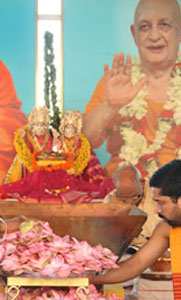
Many wondrous things came from the milky waves of the ocean as it was churned, and then suddenly, the Goddess Lakshmi, or Sri, the bestower of prosperity emerged. Radiant with beauty, she was holding a lotus and all who beheld her were enchanted. The rishis and sages spontaneously began the Sri Suktam, Ganga and the other sacred rivers offered her their waters, and the elephants of the four quarters performed her ceremonial bath. The ocean presented her with a flower garland, and Vishwakarma adorned her with heavenly ornaments. But it was the Lord Narayana who she chose to be her very own. She laid her head against his chest and in so doing, turned her gaze upon the devas and away from the asuras.
After their victory, Indra is again seated on his throne. Overcome with gratitude he eulogises the Goddess Lakshmi and says, “I bow down to Sri, the mother of all beings, who is seated on the person of Narayana. Abandoned by thee, the worlds were on the brink of ruin, but have now been saved. From thy propitious gaze, men obtain wives, children, dwellings, friends, harvest and wealth. Health and strength, power, victory and happiness are easy of attainment to those upon who thou smiles. Thou art the mother of all beings, as Narayana is their father. I pray, do not forsake our dwellings, families and friends. They who are abandoned by you are deserted by truth, purity, goodness and by every benevolent quality. Prosperity and happiness will disappear from life and all merits and advantages become worthless if you avert your gaze.” Pleased with Indra’s devotion the Goddess fulfils his wishes. Lakshmi promises, “I will not abandon the three worlds again. Nor I will ever turn my face away from the one who sings my praises morning and evening as you have done.”
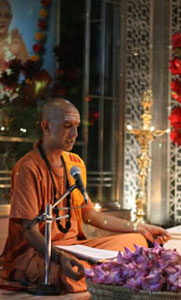
Lakshmi is the consort of Narayana, as he is all pervading, so she is omnipresent. If Lakshmi is speech, Narayana is the meaning, he is righteousness, she is devotion, he is the creator, she is creation, Lakshmi is the earth and Narayana is the support. If Narayana is the moon, Lakshmi is his unfading light. She is the creeping vine, and he is the tree around which she clings. She is the night, and he is the day. They can never be separated and in the same manner as Narayana descends to the Earth in different forms in different ages, so does Lakshmi. When Narayana incarnated as Vamana avatar, the dwarf, Lakshmi was born from a lotus as Kamala, during the time of Parasurama, Lakshmi was Dharani, for Rama she became Sita, and for Krishna she is Rukmini. Whenever the Lord appears, Sri is also there.
The real grace of Lakshmi is seen in the quality of contentment in life. The poorest man in the world is richer than a king if he has contentment, yet the man who has every material possession available will never be at peace unless and until his mind rests content. Without contentment, peace is impossible and prosperity is a mirage. But when Lakshmi turns her gaze upon you, contentment grows in the heart. It is then that peace, plenty and prosperity become established in life.
